Saturday, July 5
 After
another full English breakfast (eggs, bacon, sausage, mushrooms, tomatoes,
toast, juice, tea) - all served personally by Mike - we made the 10 minute
drive to Bath. Bath is surprising large (84,000 residents), and becomes very
busy in the summer (over 2 million tourists each year). We were a little surprised
by the fast paced traffic and the extent of the commercialism in Bath, but
there's no denying the beauty of the city. Bath is best known for the Roman
Baths which have been discovered and preserved, and for the beautiful Georgian
architecture which is everywhere. In fact, there's a conflict between those
who want more of the Roman ruins to be excavated, and those who want to protect
the Georgian buildings that sit over those remains. ~Steve
After
another full English breakfast (eggs, bacon, sausage, mushrooms, tomatoes,
toast, juice, tea) - all served personally by Mike - we made the 10 minute
drive to Bath. Bath is surprising large (84,000 residents), and becomes very
busy in the summer (over 2 million tourists each year). We were a little surprised
by the fast paced traffic and the extent of the commercialism in Bath, but
there's no denying the beauty of the city. Bath is best known for the Roman
Baths which have been discovered and preserved, and for the beautiful Georgian
architecture which is everywhere. In fact, there's a conflict between those
who want more of the Roman ruins to be excavated, and those who want to protect
the Georgian buildings that sit over those remains. ~Steve
 We
drove to Bath and first visited some Roman bath houses that were truly amazing.
Just beyond the entrance came the Great Bath House which was the central bath
in the complex. Surrounding the walls of the house were some beautifully constructed
statues of Roman emperors who ruled over Britain. In the center was an enormous
pool carved out of stone, and filled with green, 80 degree Fahrenheit water.
It is believed by scientists that the water in the pool today is original
rainwater from 10,000 years ago.
We
drove to Bath and first visited some Roman bath houses that were truly amazing.
Just beyond the entrance came the Great Bath House which was the central bath
in the complex. Surrounding the walls of the house were some beautifully constructed
statues of Roman emperors who ruled over Britain. In the center was an enormous
pool carved out of stone, and filled with green, 80 degree Fahrenheit water.
It is believed by scientists that the water in the pool today is original
rainwater from 10,000 years ago.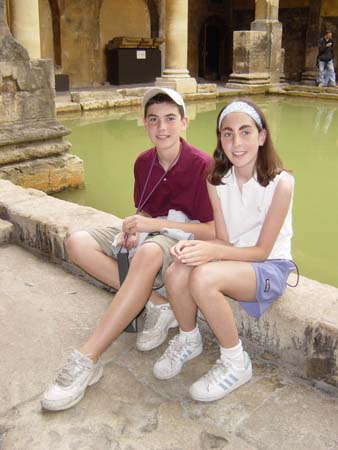
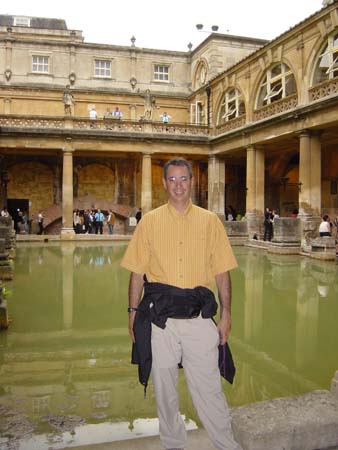 Because the water is untreated, it contains lots of algae and sulfur which
makes it dangerous to drink or touch. We were sitting on the actual steps
the Romans stepped on over 2,000 years ago. One of the things that was most
interesting about the bath house was the draining systems. The Romans made
them so well that they are still functioning today. After viewing this fascinating
bath, we entered another house called the Sacred Spring. The Romans didn't
bathe here, but instead made sacrifices to the goddess Sulis Minerva. They
would throw coins and pots into the spring or write blessings or curses on
pieces of paper. They displayed some of the notes that the people threw into
the spring, and were able to translate them despite their age. Most of them
were asking Minerva to curse certain people who they believed had committed
crimes such as stealing. We viewed actual coins that they threw into the springs
and had gotten trapped in the draining system centuries ago. One of the things
most interesting about the water in the spring was how it bubbled. The bubbling
water was not because of the heat, but from gasses and pressure underground.
After this, we looked at some remains of a temple that was once part of the
complex. ~Katie
Because the water is untreated, it contains lots of algae and sulfur which
makes it dangerous to drink or touch. We were sitting on the actual steps
the Romans stepped on over 2,000 years ago. One of the things that was most
interesting about the bath house was the draining systems. The Romans made
them so well that they are still functioning today. After viewing this fascinating
bath, we entered another house called the Sacred Spring. The Romans didn't
bathe here, but instead made sacrifices to the goddess Sulis Minerva. They
would throw coins and pots into the spring or write blessings or curses on
pieces of paper. They displayed some of the notes that the people threw into
the spring, and were able to translate them despite their age. Most of them
were asking Minerva to curse certain people who they believed had committed
crimes such as stealing. We viewed actual coins that they threw into the springs
and had gotten trapped in the draining system centuries ago. One of the things
most interesting about the water in the spring was how it bubbled. The bubbling
water was not because of the heat, but from gasses and pressure underground.
After this, we looked at some remains of a temple that was once part of the
complex. ~Katie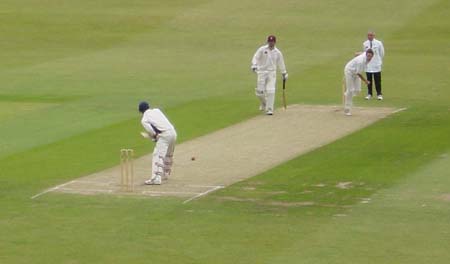
We walked through the streets of Bath and along the Avon River, stopping
to watch another cricket match at the Bath Cricket Club. We then drove over
a set of hills to a small town called Bradford-on-Avon. Bradford was full
of small windy roads and small shops that we explored before driving back
to Monks Hill for a final game of croquet. Katie finally got a chance to sit
and paint in the garden-a lovely watercolor of the fish pond complete with
water lilies. We returned our rental car (safe and sound!) at the train station,
and caught a 7:30PM train back to London's Paddington station. ~Steve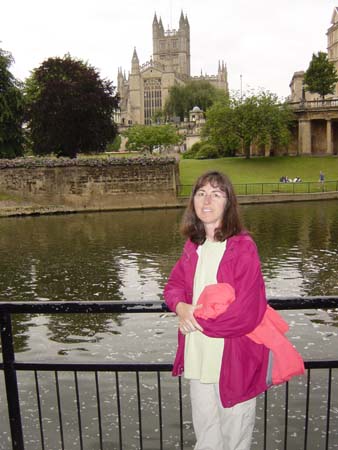
Staying at Monkshill breakfast also gave us a feel for what the English consider
"proper etiquette." We all made our share of "blunders"
including not placing our utensils on our plates in the proper manner to indicate
we were done eating. We were also guilty of "switching" which Mike
told us gives us a way as Americans (this means switching your knife and fork
back and forth to constantly use your dominant hand). Mike also scolded us
all (in good fun, but he definitely had a serious message to deliver) about
use of our saucers and proper placement of our food and glasses. All this,
plus a very proper instruction on croquet the night before, had the kids really
wondering about growing up English! ~Paula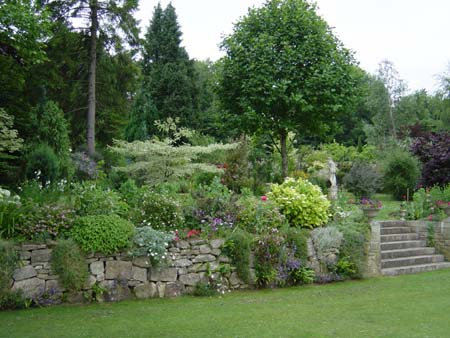
The gardens of Monkshill were lovely around the house and the variety of trees, shrubs and flowers quite impressive. This display of flowers is found throughout England, in each home and small flat and every street corner and storefront. I'm convinced that the addiction to gardening has at least something to do with the need to use flowers to brighten the landscape. While the land is lush and green from the frequent rain and constant moisture, the gray skies and stone architecture would be cold and solemn without the cheerful floral displays. ~Paula
Distance Walked: 2.53 miles
